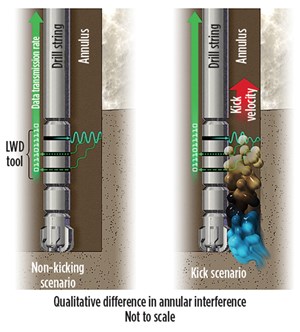Drilling advances
Scientists at a federal laboratory in Oregon believe geophysical measurements, usually consigned to some data dustbin, hold a key to making drilling a bit safer, and cheaper.
Simply put, intra-wellbore data streams, entrained within while-drilling measurements and tossed aside as useless background noise, possibly can be filtered out and re-processed to alert drillers to a potential kick, and well before it gets out of hand. So say researchers at the U.S. Department of Energy’s (DOE) National Energy Technology Laboratory (NETL) in Albany, N.Y., who have backed up the concept in the patent-pending “Kick Detection at the Bit Using Wellbore Geophysics.” However, to transition from the conceptual to a field-proven reality, NETL says it wants to hear from anyone willing to share un-scrubbed real-world data sets.
In the meantime, what may best be described as the embodiment of recycling, Kelly Rose, the geology and geophysical team lead at NETL’s R&D facility, says the distinctive algorithms and reprocessing approach converts once wasted measurements into data that conceivably can deliver near-real time warning of oil, gas or water invasion from the formation. Complementing its obvious safety ramifications, the capacity to quickly recognize changes in wellbore pressure at the vicinity of the bit also could reduce associated non-productive time (NPT). During research for the patent, Rose said, industry sources indicated that dealing with abnormal pressures accounts for around $8 billion/year and upwards of 44% of NPT.

“They’re already collecting it, so rather than throw out the extraneous data, this filtering and reprocessing approach gives them a chance, with very minimal costs, to reduce risks and better understand what’s happening downhole,” she said.
Specifically, the early kick detection idea leverages wireline, logging-while-drilling (LWD), measurement-while drilling (MWD), seismic-while drilling (SWD) and other data commonly collected and analyzed during drilling. “All these downhole geophysical tools were developed with an initial purpose in mind, which is to look outside the wellbore,” she explains. “They work kind of like a GPS for the driller, geoscientist and engineer, to tell them where they are and where they are going. It’s all outward-looking.”
Within the subsequent logs, however, resides key information on the geologic strata, as well as the fluids, gases and other pore-filling media surrounding the borehole, which basically is ignored. With the NETL concept, Rose said, multiple telemetry-delivered signals transferred at essentially the speed of sound, from the wellbore bottom to the rig floor, would be processed “in a minute or less” through the filtering algorithms. The results could show if “something kick-like” was occurring at the bit and, rather than waiting for physical evidence to reach the mud pit, give the driller ample time to react before it degrades into a serious well control issue.
“There are different ways of re-bundling the data, so we think we can help identify if it’s an oil kick, a gas kick or a water kick. A further study we’re working on is calibration, because we also believe that with experimental studies, we can help say something about the volume coming into the wellbore.”
With potentially advantageous data being scrapped, operators must rely on alternative tools and methodologies to predict and manage geopressure and kick-related phenomena. While these tools will always be required for higher-risk operations, Rose said the NETL concept could ease the economic pain for less-risky wells. “Every time you add a tool or technique to the operation, the price tag goes up. You’re also putting more equipment at risk, it’s not cheap, and there’s more uncertainty. What we’re trying to do, which we’ve proven theoretically, mathematically and physically, is recycle data that’s already been collected that previously was considered noise and filtered out,” she said.
Partners sought
Therein lies the main obstacle to full-blown exploitation of the technology, and that’s why NETL is actively seeking industry partners willing to provide unfiltered geophysical data for the final validation. “Most of the logging data that comes out of these wells has already been filtered, so the information we need has been thrown away. We’ve completed all the theoretical paper-based and computational-based validation. Conceptually, we think it’s solid, but now we need the opportunity to partner with industry folks, to apply it to an entire suite of data sets and further validate the process with real-world data,” she said.
Since NETL is not in the commercialization business, once the theory has been field-proven, the next step is for a company to recognize the economic potential. “The hope would be that someone on the industry side would package it in such a way that it could become a computer-user interface on the rig floor for the driller to use,” she said. “Ideally, we’d like an industry partner to pick it up and run with it.” ![]()

- Coiled tubing drilling’s role in the energy transition (March 2024)
- Digital tool kit enhances real-time decision-making to improve drilling efficiency and performance (February 2024)
- E&P outside the U.S. maintains a disciplined pace (February 2024)
- Prices and governmental policies combine to stymie Canadian upstream growth (February 2024)
- U.S. operators reduce activity as crude prices plunge (February 2024)
- U.S. producing gas wells increase despite low prices (February 2024)
- Applying ultra-deep LWD resistivity technology successfully in a SAGD operation (May 2019)
- Adoption of wireless intelligent completions advances (May 2019)
- Majors double down as takeaway crunch eases (April 2019)
- What’s new in well logging and formation evaluation (April 2019)
- Qualification of a 20,000-psi subsea BOP: A collaborative approach (February 2019)
- ConocoPhillips’ Greg Leveille sees rapid trajectory of technical advancement continuing (February 2019)


